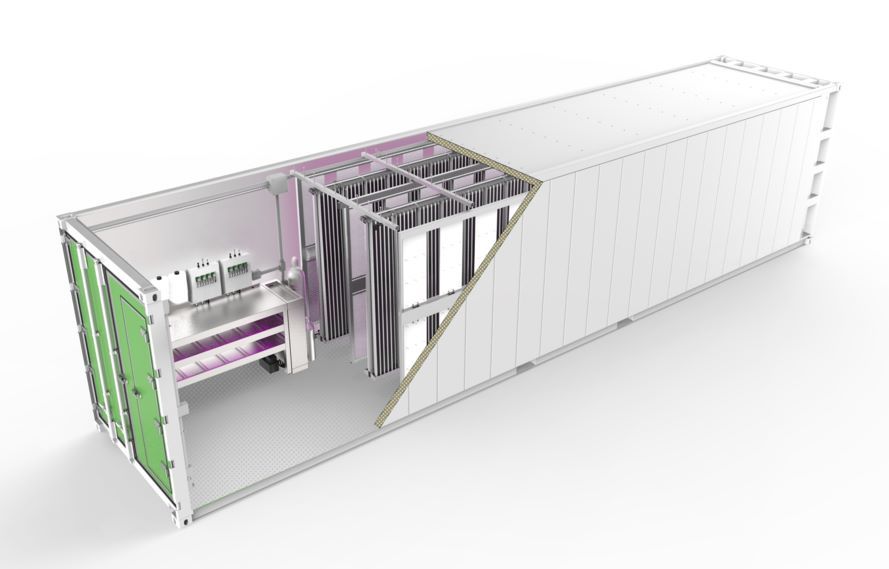Let’s talk shipping containers farms! I’m going to review how much progress the industry has made when it comes to growing in an intermodal container, focussing on who is building them and what makes them a great vessel for your urban farm. Never even heard of container farming before? I’ve got you covered, too.
We should acknowledge that a shipping container isn’t cheap, so it’s crucial to conduct thorough research so you can make an educated decision. By the end of this post, you will be able to decide whether container farming is the right approach and investment for you, and if so, you will be able to pick the shipping container that is best for your urban farming goals.
What’s container farming?
Containers are abundant in our world and people are coming up with different creative applications, from prefab homes to markets like stackt in Toronto. Shipping container farms started as a DIY project, but now there are established companies handling all aspects of the urban farming experience using these cargo boxes.
In short, container farming entails growing food in large boxes, generally used to move products around the world on freight transport. Normally measuring 20′ to 40′ in length, these containers are retrofitted with rows of shelves to grow plants in a controlled environment. If you’re having trouble visualizing all this, Local Roots Farms has a 3D tour of a vertical farm in a storage container.

 Benefits
Benefits
- Shipping containers are abundant and can be found almost anywhere in the world.
- They are standardized and portable: they are part of a massive industry, which means it will be easy to acquire and transport one.
- Like Lego bricks, shipping containers can be stacked vertically.
- They have strong doors that can be locked and kept safe, which can be very beneficial depending on where you want to set up your farm.
- This method uses less water, as most shipping container farms are hydroponic and will recycle the water. Companies say they use 97% less water than conventional watering practices.
- Containers offer protection from the elements, as they are meant to stand up to them. From salt water and direct contact to the sun as they are shipped around the world. Depending on where you want to grow they will be able to handle what nature brings your way.
- Brings farming to food deserts and disaster areas. When it is hard to find land to grow food, these shipping containers can be set up, shipped out, and ready to grow. This is a huge humanitarian benefit if there isn’t ground to grow in or if a disaster has struck.
 Drawbacks
Drawbacks
- Shipping containers are not designed for farming. To use them for growing, you will need to spend time retrofitting them for this new purpose. For a lover of DIY projects, this wouldn’t be a shortcoming at all! You can read more about this hands-on aspect below.
- A used container may not have good longevity, so be careful and inspect them before you buy it. These boxes have been travelling around the world, holding heavy cargo, meaning they are exposed to the elements. The fact they are being sold means they no longer withstand the transport.
- Farming in a shipping container may not give you the desired yield. With the cost of purchasing and retrofitting, you might find it better to acquire a greenhouse. It really depends on where you are located and the unique environment that you are growing in.
Dr. Nate Storey of ZipGrow has an amazing video that goes over the pros and cons of a shipping container farm. I’ve personally learned so much from him. You can take a look at his video below.
 Where to put your shipping container farm
Where to put your shipping container farm
- Driveway. Since it’s a shipping container, it will fit in standard driveways and in many cases, you will still be able to park your car.
- Backyard. Shipping containers are well-designed both on the inside and out, so in ways they are not so bad to look at, adding an industrial aesthetic to your outdoor space.
- Away from power lines. A crane will drop off your container, and it will need to extend high into the sky to do this, so keep this in mind when you look for a space.
- A place that can support weight. A 20′ container weighs about 2,300 kg (5,071 Ibs) and a 40′ one about 3,750 kg (8,267 lbs), not including plants, water, and growing equipment. Ensure that the designated spot for the container can sustain all this.
- A level spot. Since many of these container farms use hydroponics to grow, it is important to ensure that it is level so the water will flow according to the design.
- Close to you. With this much production going on, you will be able to harvest food all the time — probably even more than what a small family can consume, so make sure you can have easy access to it.
- Close to utilities. This is not so important, but you will need to hook your container up to a power and water supply. It’s not much of a cost in comparison to the container itself but it’s still something to consider.
If you are still interested check out my post on shipping containers that are ready to purchase and all set up to grow food in. READ POST
Updated July 23, 2021. Originally published February 4, 2020.






